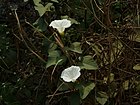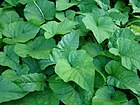Note: This is a project under development. The articles on this wiki are just being initiated and broadly incomplete. You can Help creating new pages.
Operculina turpethum - Trivrit
Ksharaka, Adenanthera pavonina is a fast-growing deciduous tree with a spreading crown of light, feathery foliage. The tree is widely cultivated in the tropics for a wide range of uses. A very ornamental plant with fragrant, creamy flowers, it is often grown as a specimen and as a street tree.
Contents
- 1 Uses
- 2 Parts Used
- 3 Chemical Composition
- 4 Common names
- 5 Properties
- 6 Habit
- 7 Identification
- 8 List of Ayurvedic medicine in which the herb is used
- 9 Where to get the saplings
- 10 Mode of Propagation
- 11 How to plant/cultivate
- 12 Commonly seen growing in areas
- 13 Photo Gallery
- 14 References
- 15 External Links
Uses
Constipation, Worm infestation, Inflammation, Spleen diseases, Heart disorders, Bloating [1]
Parts Used
Chemical Composition
Common names
| Language | Common name |
|---|---|
| Kannada | alutigade, bili tigade, aluthi gida, bangada balli |
| Hindi | nisotar, nisoth, nukpatar, tarbut |
| Malayalam | sivata, chivaka, trikolpakkonna |
| Tamil | adimbu, saralam, kumbham, shivadai-ver |
| Telugu | erra tegada, nalla tegada |
| Marathi | NA |
| Gujarathi | NA |
| Punjabi | NA |
| Kashmiri | NA |
| Sanskrit | ardhachandra, arunatrivrt, tribhandi, sarala |
| English | turpeth root |
Properties
Reference: Dravya - Substance, Rasa - Taste, Guna - Qualities, Veerya - Potency, Vipaka - Post-digesion effect, Karma - Pharmacological activity, Prabhava - Therepeutics.
Dravya
Rasa
Tikta (Bitter), Katu (Pungent)
Guna
Laghu (Light), Rooksha (Dry), Teekshna (Piercing)
Veerya
Ushna (Hot)
Vipaka
Karma
Kapha, Pitta
Prabhava
Rechana (Causes purgation)
Habit
Identification
Leaf
| Kind | Shape | Feature |
|---|---|---|
| Simple | alternate | Leaves alternate, broadly ovate, 5-10 by 4-8.5 cm, base cordate, apex acute or obtuse, mucronate, thinly pubescent; petiole 2-7 cm long. |
Flower
| Type | Size | Color and composition | Stamen | More information |
|---|---|---|---|---|
| Bisexual | Solitary or few in axillary cymes | White | Flower(s) solitary or few in axillary cymes. Calyx lobes ovate, outer larger, 2 by 1.5 cm, thick coriaceous at age.cCrolla white, c. 3 cm across. Ovary 2-locular. |
Fruit
| Type | Size | Mass | Appearance | Seeds | More information |
|---|---|---|---|---|---|
| A capsule | Ovoid | seeds glabrous | {{{5}}} | {{{6}}} |
Other features
List of Ayurvedic medicine in which the herb is used
Where to get the saplings
Mode of Propagation
How to plant/cultivate
Season to grow
Soil type
Propagation
Commonly seen growing in areas
Photo Gallery
References
External Links
- https://www.planetayurveda.com/library/trivrit-operculina-turpethum
- https://www.ncbi.nlm.nih.gov/pmc/articles/PMC5628523/
- https://www.google.com/search?q=operculina+turpethum+ayurveda&oq=operculina+turpethum+&aqs=chrome.4.69i57j0l5.8417j0j4&sourceid=chrome&ie=UTF-8
- http://tropical.theferns.info/viewtropical.php?id=Operculina+turpethum
- Ayurvedic Herbs known to be helpful to treat Constipation
- Ayurvedic Herbs known to be helpful to treat Worm infestation
- Ayurvedic Herbs known to be helpful to treat Inflammation
- Ayurvedic Herbs known to be helpful to treat Spleen diseases
- Ayurvedic Herbs known to be helpful to treat Heart disorders
- Ayurvedic Herbs known to be helpful to treat Bloating
- Herbs with Roots used in medicine
- Herbs with Leaves used in medicine
- Herbs with common name in Kannada
- Herbs with common name in Hindi
- Herbs with common name in Malayalam
- Herbs with common name in Tamil
- Herbs with common name in Telugu
- Herbs with common name in Sanskrit
- Herbs with common name in English
- Habit - Climber
- Index of Plants which can be propagated by Seeds
- Index of Plants which can be propagated by Cuttings
- Herbs that are commonly seen in the region of Tropical area
- Herbs
- Climber





